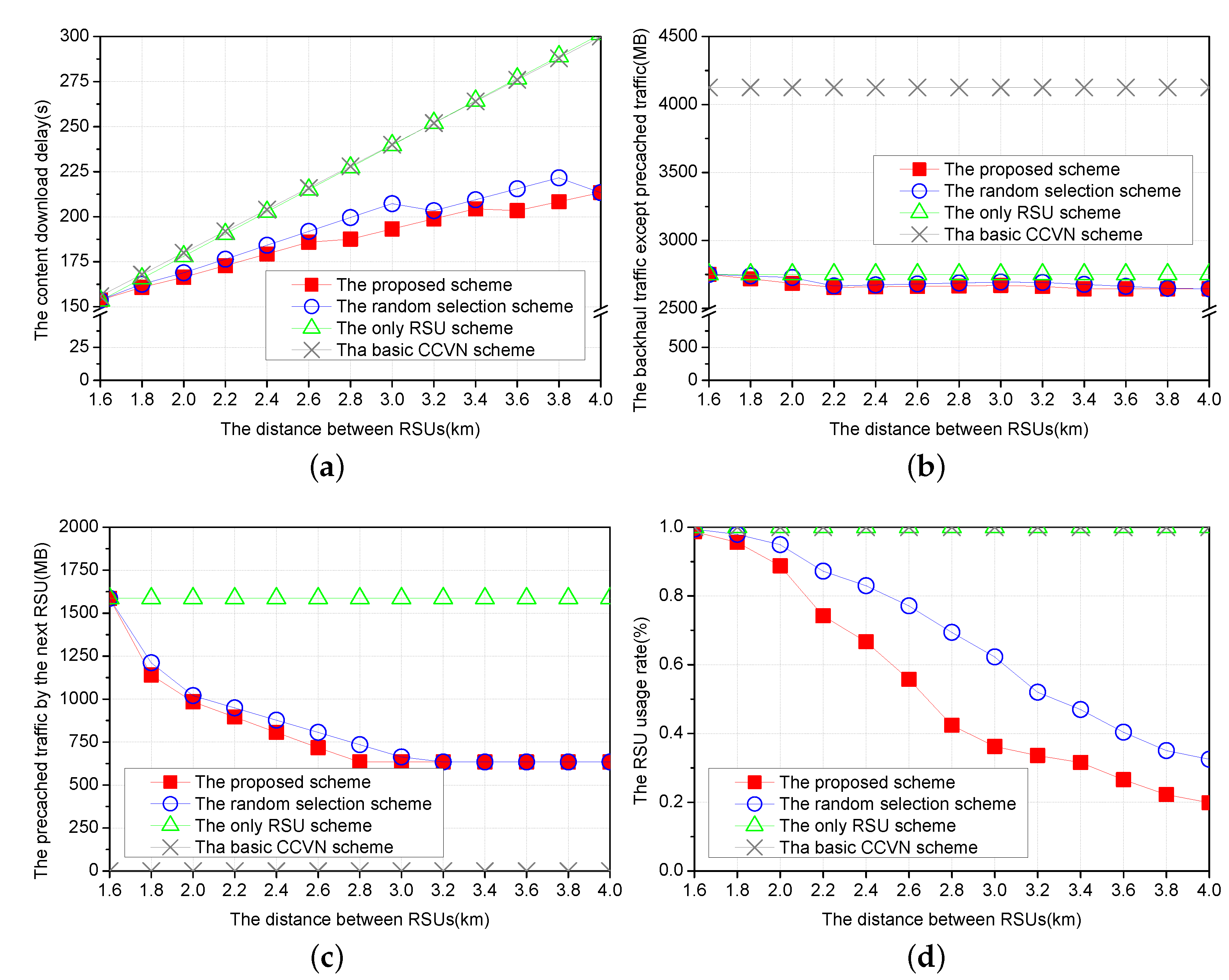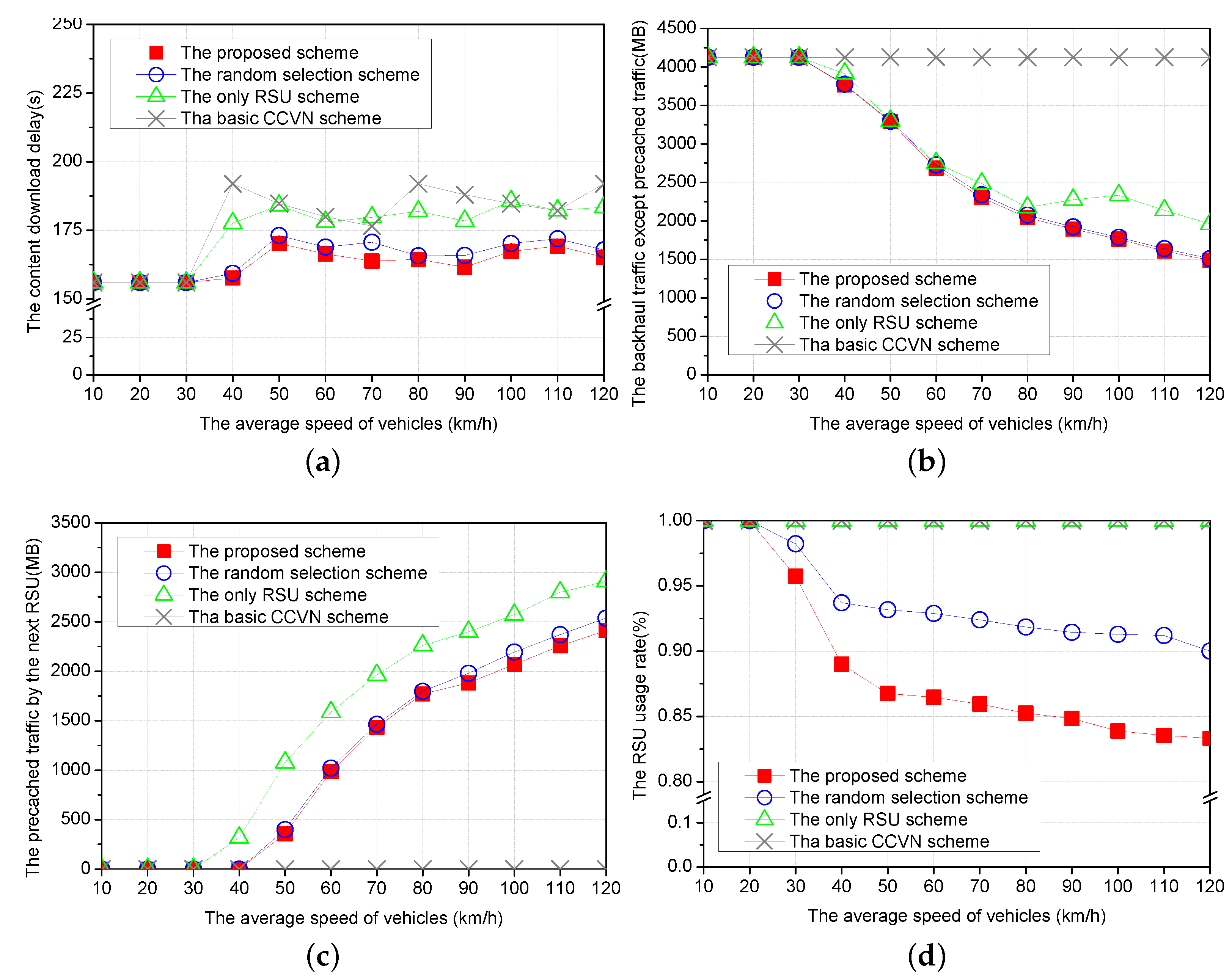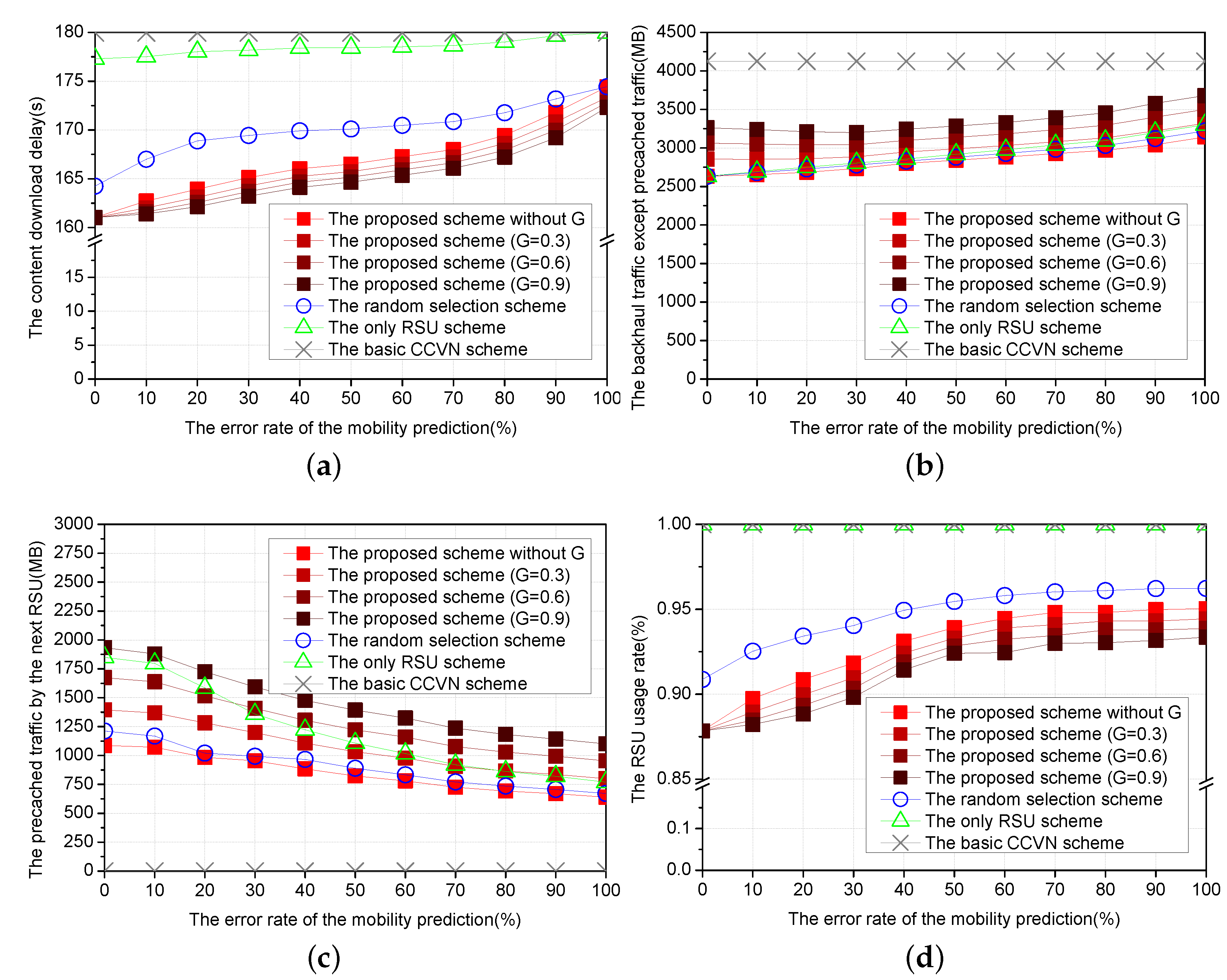Cooperative Content Precaching Scheme Based on the Mobility Information of Vehicles in Intermittently Connected Vehicular Networks
Abstract
1. Introduction
2. Network Model and Overview
3. The Selection of the Optimal Relaying Vehicle
3.1. Checking the Necessity for Precaching
3.2. Selection of the Optimal Relaying Vehicle
3.2.1. The Downloadable Time and Amount
3.2.2. The Relaying Time and Amount
3.2.3. Selection of the Optimal Relaying Vehicle
3.3. Optimal Content Precaching to Next RSU
| Algorithm 1: Cooperative Content Precaching |
Input: the content c, the RSU j’s coverage , the requester vehicle ’s the location and the velocity Output: Action of the RSU j
|
4. Guardband for Handling the Mobility Prediction Errors
4.1. Dwell Time in an RSU
4.2. Contact Time with the Relaying Vehicle
4.3. Calculation of the Guardband
5. Performance Evaluation
5.1. Simulation Model and Scenario
- The content download delay [s], the time in which receives the entire amount of the content from the RSUs and the relaying vehicles;
- The backbone traffic except precached traffic [MB]: It is the total amount of backhaul traffic consumed to provide the content to using a backbone;
- The precached traffic by the next RSUs [MB]: It is through the prediction, the total amount of traffic consumed by the next RSUs to precache the remaining amount of content that has to receive when the current RSU cannot provide the entire amount of content;
- The RSU usage ratio, [0,1]: It is the proportion of the amount of content provided from RSUs among the total amount of requested content. The time slot consumed by the RSU to provide content to cannot be used for other vehicles. Therefore, if the RSU usage ratio is small, the time slot that other vehicles can use to receive the content will increase. In addition, RSUs benefit from a storage utilization perspective because they reduce the amount of content that needs to be precached and held;
- The hit ratio ∈ [0,1]: It is the proportion of the content used by among the total amount of precached content at both RSUs and relaying vehicles. Some portion of the content that is precached at the RSUs and relaying vehicles may not be provided to because of the limited connection between and each of them. Even if they are not provided to , they consume the storage of the RSUs and relaying vehicles and are eventually removed. This causes wasted backhaul traffic from the content server and wasted storage of RSUs and relaying vehicles. Therefore, a high hit ratio implies that storage and traffic are saved.
5.2. Performance for Various Environmental Factors
5.3. Performance Based on Characteristics of Requester Vehicles
5.4. Performance for Accuracy of Vehicle Mobility Prediction
6. Discussion
6.1. Security of Privacy
6.2. Energy Consumption
6.3. Combination with 5G Technology
7. Conclusions
Author Contributions
Funding
Conflicts of Interest
References
- Karagiannis, G.; Altintas, O.; Ekici, E.; Heijenk, G.; Jarupan, B.; Lin, K.; Weil, T. Vehicular Networking: A Survey and Tutorial on Requirements, Architectures, Challenges, Standards and Solutions. IEEE Commun. Surv. Tutor. 2011, 13, 584–616. [Google Scholar] [CrossRef]
- Awang, A.; Husain, K.; Kamel, N.; Aissa, S. Routing in Vehicular Ad-hoc Networks: A Survey on Single- and Cross-Layer Design Techniques, and Perspectives. IEEE Access 2017, 5, 9497–9517. [Google Scholar] [CrossRef]
- Shahwani, H.; Shah, S.A.; Ashraf, M.; Akram, M.; Jeong, J.; Shin, J. A comprehensive survey on data dissemination in Vehicular Ad Hoc Networks. Veh. Commun. 2021, 34, 100420. [Google Scholar] [CrossRef]
- An, K.; Lin, M.; Ouyang, J.; Zhu, W.-P. Secure Transmission in Cognitive Satellite Terrestrial Networks. IEEE J. Sel. Areas Commun. 2016, 34, 3025–3037. [Google Scholar] [CrossRef]
- Lin, Z.; Niu, H.; An, K.; Wang, Y.; Zheng, G.; Chatzinotas, S.; Hu, Y. Refracting RIS-Aided Hybrid Satellite-Terrestrial Relay Networks: Joint Beamforming Design and Optimization. IEEE Trans. Aerosp. Electron. Syst. 2022, 58, 3717–3724. [Google Scholar] [CrossRef]
- Lin, Z.; Lin, M.; de Cola, T.; Wang, J.-B.; Zhu, W.-P.; Cheng, J. Supporting IoT With Rate-Splitting Multiple Access in Satellite and Aerial-Integrated Networks. IEEE Internet Things J. 2021, 8, 11123–11134. [Google Scholar] [CrossRef]
- Lin, Z.; An, K.; Niu, H.; Hu, Y.; Chatzinotas, S.; Zheng, G.; Wang, J. SLNR-based Secure Energy Efficient Beamforming in Multibeam Satellite Systems. IEEE Trans. Aerosp. Electron. Syst. 2022, 1–4. [Google Scholar] [CrossRef]
- Lee, E.; Lee, E.-K.; Gerla, M.; Oh, S.Y. Vehicular cloud networking: Architecture and design principles. IEEE Commun. Mag. 2014, 52, 148–155. [Google Scholar] [CrossRef]
- Zhang, S.; Chen, J.; Lyu, F.; Cheng, N.; Shi, W.; Shen, X. Vehicular Communication Networks in the Automated Driving Era. IEEE Commun. Mag. 2018, 56, 26–32. [Google Scholar] [CrossRef]
- Khelifi, H.; Luo, S.; Nour, B.; Moungla, H.; Faheem, Y.; Hussain, R.; Ksentini, A. Named Data Networking in Vehicular Ad Hoc Networks: State-of-the-Art and Challenges. IEEE Commun. Surv. Tutorials 2019, 22, 320–351. [Google Scholar] [CrossRef]
- Cheng, X.; Yang, L.; Shen, X. D2D for Intelligent Transportation Systems: A Feasibility Study. IEEE Trans. Intell. Transp. Syst. 2015, 16, 1784–1793. [Google Scholar] [CrossRef]
- Wang, Y.; Zheng, J.; Mitton, N. Delivery Delay Analysis for Roadside Unit Deployment in Vehicular Ad Hoc Networks With Intermittent Connectivity. IEEE Trans. Veh. Technol. 2015, 65, 8591–8602. [Google Scholar] [CrossRef]
- Lopes, L.H.S.; Mini, R.A.F.; Cunha, F. A V2X Approach for Data Dissemination in Vehicular Ad Hoc Networks. In Proceedings of the 2019 IEEE Symposium on Computers and Communications (ISCC), Barcelona, Spain, 29 June–3 July 2019; pp. 1–6. [Google Scholar] [CrossRef]
- Wang, X.; Li, Y. Content Delivery Based on Vehicular Cloud. IEEE Trans. Veh. Technol. 2019, 69, 2105–2113. [Google Scholar] [CrossRef]
- Ko, B.; Liu, K.; Son, S.H.; Park, K.-J. RSU-Assisted Adaptive Scheduling for Vehicle-to-Vehicle Data Sharing in Bidirectional Road Scenarios. IEEE Trans. Intell. Transp. Syst. 2020, 22, 977–989. [Google Scholar] [CrossRef]
- Huang, W.; Li, P.; Li, B.; Zhang, T. DMP: Content Delivery with Dynamic Movement Pattern in Vehicular Networks. IEEE Trans. Big Data 2021, 8, 1. [Google Scholar] [CrossRef]
- Reis, A.B.; Sargento, S.; Neves, F.; Tonguz, O.K. Deploying Roadside Units in Sparse Vehicular Networks: What Really Works and What Does Not. IEEE Trans. Veh. Technol. 2013, 63, 2794–2806. [Google Scholar] [CrossRef]
- Kim, D.; Velasco, Y.; Wang, W.; Uma, R.N.; Hussain, R.; Lee, S. A New Comprehensive RSU Installation Strategy for Cost-Efficient VANET Deployment. IEEE Trans. Veh. Technol. 2016, 66, 4200–4211. [Google Scholar] [CrossRef]
- Su, Z.; Hui, Y.; Yang, Q. The Next Generation Vehicular Networks: A Content-Centric Framework. IEEE Wirel. Commun. 2017, 24, 60–66. [Google Scholar] [CrossRef]
- Rao, Y.; Zhou, H.; Gao, D.; Luo, H.; Liu, Y. Proactive Caching for Enhancing User-Side Mobility Support in Named Data Networking. In Proceedings of the 2013 Seventh International Conference on Innovative Mobile and Internet Services in Ubiquitous Computing, Taichung, Taiwan, 3–5 July 2013; pp. 37–42. [Google Scholar] [CrossRef]
- Wang, Y.; Liu, Y.; Zhang, J.; Ye, H.; Tan, Z. Cooperative Store-Carry-Forward Scheme for Intermittently Connected Vehicular Networks. IEEE Trans. Veh. Technol. 2017, 66, 777–784. [Google Scholar] [CrossRef]
- Suthaputchakun, C.; Sun, Z. Multihop Broadcast Protocol in Intermittently Connected Vehicular Networks. IEEE Trans. Aerosp. Electron. Syst. 2017, 54, 616–628. [Google Scholar] [CrossRef]
- Wu, D.; Zhu, G.; Zhao, D. Adaptive Carry-Store Forward Scheme in Two-Hop Vehicular Delay Tolerant Networks. IEEE Commun. Lett. 2013, 17, 721–724. [Google Scholar] [CrossRef]
- Zhou, H.; Cheng, N.; Wang, J.; Chen, J.; Yu, Q.; Shen, X. Toward Dynamic Link Utilization for Efficient Vehicular Edge Content Distribution. IEEE Trans. Veh. Technol. 2019, 68, 8301–8313. [Google Scholar] [CrossRef]
- Wang, R.; Peng, X.; Zhang, J.; Letaief, K.B. Mobility-aware caching for content-centric wireless networks: Modeling and methodology. IEEE Commun. Mag. 2016, 54, 77–83. [Google Scholar] [CrossRef]
- Grewe, D.; Wagner, M.; Frey, H. PeRCeIVE: Proactive caching in ICN-based VANETs. In Proceedings of the 2016 IEEE Vehicular Networking Conference (VNC), Columbus, OH, USA, 8–10 December 2016; pp. 1–8. [Google Scholar] [CrossRef]
- Lai, C.; Zhang, K.; Cheng, N.; Li, H.; Shen, X. SIRC: A Secure Incentive Scheme for Reliable Cooperative Downloading in Highway VANETs. IEEE Trans. Intell. Transp. Syst. 2016, 18, 1559–1574. [Google Scholar] [CrossRef]
- Mershad, K.; Artail, H.; Gerla, M. ROAMER: Roadside Units as message routers in VANETs. Ad Hoc Networks 2012, 10, 479–496. [Google Scholar] [CrossRef]
- Choi, J.-H.; Han, Y.-H.; Min, S.-G. A Network-Based Seamless Handover Scheme for VANETs. IEEE Access 2018, 6, 56311–56322. [Google Scholar] [CrossRef]
- Paridel, K.; Balen, J.; Berbers, Y.; Martinovic, G. VVID: A Delay Tolerant Data Dissemination Architecture for VANETs Using V2V and V2I Communication. In +MOBILITY, International Conference on Mobile Services, Resources, and Users; Xpert Publishing Services: Wilmington, DE, USA, 2012; pp. 151–156. [Google Scholar]
- Giang, A.T.; Busson, A.; Lambert, A.; Gruyer, D. Spatial Capacity of IEEE 802.11p-Based VANET: Models, Simulations, and Experimentations. IEEE Trans. Veh. Technol. 2015, 65, 6454–6467. [Google Scholar] [CrossRef]
- Arena, F.; Pau, G.; Severino, A. A Review on IEEE 802.11p for Intelligent Transportation Systems. J. Sens. Actuator Netw. 2020, 9, 22. [Google Scholar] [CrossRef]
- Network Simulator 3 (ns3). Available online: https://www.nsnam.org (accessed on 17 August 2022).
- RouteMobilityModel. Available online: https://www.nsnam.org/wiki/RoutesMobilityModel (accessed on 17 August 2022).
- Paier, A.; Tresch, R.; Alonso, A.; Smely, D.; Meckel, P.; Zhou, Y.; Czink, N. Average Downstream Performance of Measured IEEE 802. In 11p Infrastructure-to-Vehicle Links. In Proceedings of the 2010 IEEE International Conference on Communications Workshops, Cape Town, South Africa, 23–27 May 2010; pp. 1–5. [Google Scholar] [CrossRef]
- Breslau, L.; Cao, P.; Fan, L.; Phillips, G.; Shenker, S. Web caching and Zipf-like distributions: Evidence and implications. In Proceedings of the Eighteenth Annual Joint Conference of the IEEE Computer and Communications Societies (INFOCOM ’99). The Future Is Now (Cat. No.99CH36320), New York, NY, USA, 21–25 March 1999; Volume 1, pp. 126–134. [Google Scholar] [CrossRef]
- Yellanki, P.; Narasimham, M.P. Secure Routing Protocol for VANETS using ECC. In Proceedings of the 2020 International Conference on Computer Science, Engineering and Applications (ICCSEA), Gunupur, India, 13–14 March 2020; pp. 1–5. [Google Scholar] [CrossRef]
- Chai, H.; Leng, S.; Zeng, M.; Liang, H. A Hierarchical Blockchain Aided Proactive Caching Scheme for Internet of Vehicles. In Proceedings of the ICC 2019—2019 IEEE International Conference on Communications (ICC), Shanghai, China, 20–24 May 2019; pp. 1–6. [Google Scholar] [CrossRef]
- Tran, T.X.; Kazemi, F.; Karimi, E.; Pompili, D. Mobee: Mobility-Aware Energy-Efficient Coded Caching in Cloud Radio Access Networks. In Proceedings of the 2017 IEEE 14th International Conference on Mobile Ad Hoc and Sensor Systems (MASS), Orlando, FL, USA, 22–25 October 2017; pp. 461–465. [Google Scholar] [CrossRef]
- Shen, R.; Zhang, D.; Zhang, Y.; Yang, T.; Zhang, Y. A Block Prefetching Framework for Energy Harvesting IoT Devices. IEEE Internet Things J. 2020, 7, 3427–3440. [Google Scholar] [CrossRef]
- Ahani, G.; Yuan, D. On Optimal Proactive and Retention-Aware Caching with User Mobility. In Proceedings of the 2018 IEEE 88th Vehicular Technology Conference (VTC-Fall), Chicago, IL, USA, 27–30 August 2018; pp. 1–5. [Google Scholar] [CrossRef]
- Dong, L.; Ni, Q.; Wu, W.; Huang, C.; Znati, T.; Du, D.Z. A Proactive Reliable Mechanism-Based Vehicular Fog Computing Network. IEEE Internet Things J. 2020, 7, 11895–11907. [Google Scholar] [CrossRef]
- Mehteroglu, C.; Durmus, Y.; Onur, E. Semantic edge caching and prefetching in 5G. In Proceedings of the 2017 14th IEEE Annual Consumer Communications & Networking Conference (CCNC), Las Vegas, NV, USA, 8–11 January 2017; pp. 692–695. [Google Scholar] [CrossRef]
- Liang, C.; Yu, F.R.; Dao, N.; Senarath, G.; Farmanbar, H. Enabling Adaptive Data Prefetching in 5G Mobile Networks with Edge Caching. In Proceedings of the 2018 IEEE Global Communications Conference (GLOBECOM), Abu Dhabi, United Arab Emirates, 9–13 December 2018; pp. 1–6. [Google Scholar] [CrossRef]







| Notation | Description |
|---|---|
| j-th roadside unit (RSU), where | |
| i-th vehicle, where | |
| The requester vehicle | |
| The selected optimal relaying vehicle | |
| The maximum time that Vi can relay the content to Vreq within the outage zone | |
| The downloadable time for providing the requested content to within the coverage of | |
| The downloadable time for precaching the requested content to within the coverage of | |
| The relaying time of for providing the precached content to within the outage zone | |
| The coverage diameter of | |
| The current location of | |
| The current location of | |
| The current speed of | |
| The current speed of | |
| The transmission rate of the I2V | |
| The transmission rate of the V2V | |
| The total size of the requested content | |
| The downloadable amount of the requested content for providing the requested content to within the coverage of | |
| The downloadable amount of the requested content for precaching it to within the coverage of | |
| The relaying amount of the content for providing it to within the outage zone | |
| The maximum amount of the requested content for providing it from to within the outage zone by precaching it to from to within the coverage of | |
| The relaying amount of the precached content for providing it to within the outage zone | |
| The coverage radius of the vehicles | |
| U | The distance of the outage zone between and |
| Notation | Description |
|---|---|
| The expected reduced delay value by G of guardband and of mobility error ratio | |
| The theoretical delay value in an ideal situation | |
| The actual estimated delay value that is obtained by the predicted situation | |
| The theoretical distance value in an ideal situation | |
| The actual estimated distance value that is obtained by the predicted situation | |
| l | The transmission rate of backhaul links |
| One or zero value whether provides the requested content to after moves a distance of m meters | |
| One or zero value whether provides the precached content to after moves a distance of m meters | |
| The mobility error ratio of the vehicles | |
| The expected speed based on at the coverage of | |
| The average expected speed based on and at the coverage of | |
| The average expected speed based on and at the outage zone between and | |
| The average expected speed based on and at the outage zone between and | |
| One or zero value whether relays the requested content to after moves a distance of m meters | |
| One or zero value whether provides the precached content to after moves a distance of m meters | |
| One or zero value whether and are connected after moves a distance of m meters | |
| One or zero value whether stays within the outage zone between and after moves a distance of m meters | |
| The expected reduced traffic by G of guardband and of mobility error ratio | |
| The theoretical traffic value in ideal situation | |
| The actual estimated traffic value that is obtained by the predicted situation |
| Parameters | Value |
|---|---|
| link latency | 10 ms |
| radio channel rate | 54 Mbps |
| backhaul rate | 1 Gbps |
| distance between RSUs | [1.6, 4] km |
| vehicle density | [25, 250] per km |
| size of the content catalog | 10 |
| exponent of content popularity | 0.75 |
| chunk size | 25 kbytes |
| content size | [500, 3500] MB |
| vehicle speed | [10, 120] km/h |
| V2I Communication range | 800 m |
| V2V Communication range | 200 m |
| vehicle cache storage | 512 GB |
| RSU cache storage | 1 TB |
| prediction error | [0,1] |
| G guardband | [0,1] |
Publisher’s Note: MDPI stays neutral with regard to jurisdictional claims in published maps and institutional affiliations. |
© 2022 by the authors. Licensee MDPI, Basel, Switzerland. This article is an open access article distributed under the terms and conditions of the Creative Commons Attribution (CC BY) license (https://creativecommons.org/licenses/by/4.0/).
Share and Cite
Nam, Y.; Bang, J.; Choi, H.; Shin, Y.; Lee, E. Cooperative Content Precaching Scheme Based on the Mobility Information of Vehicles in Intermittently Connected Vehicular Networks. Electronics 2022, 11, 3663. https://doi.org/10.3390/electronics11223663
Nam Y, Bang J, Choi H, Shin Y, Lee E. Cooperative Content Precaching Scheme Based on the Mobility Information of Vehicles in Intermittently Connected Vehicular Networks. Electronics. 2022; 11(22):3663. https://doi.org/10.3390/electronics11223663
Chicago/Turabian StyleNam, Youngju, Jaejeong Bang, Hyunseok Choi, Yongje Shin, and Euisin Lee. 2022. "Cooperative Content Precaching Scheme Based on the Mobility Information of Vehicles in Intermittently Connected Vehicular Networks" Electronics 11, no. 22: 3663. https://doi.org/10.3390/electronics11223663
APA StyleNam, Y., Bang, J., Choi, H., Shin, Y., & Lee, E. (2022). Cooperative Content Precaching Scheme Based on the Mobility Information of Vehicles in Intermittently Connected Vehicular Networks. Electronics, 11(22), 3663. https://doi.org/10.3390/electronics11223663







